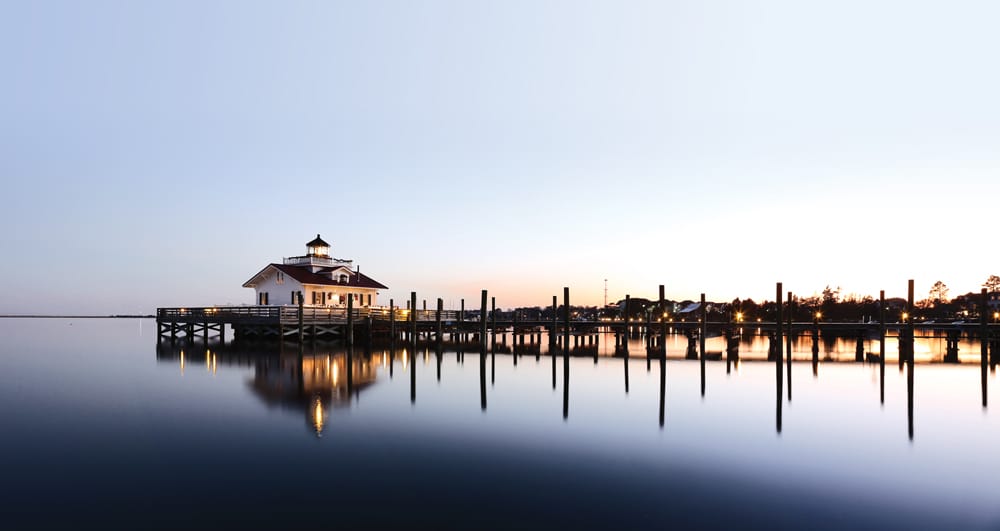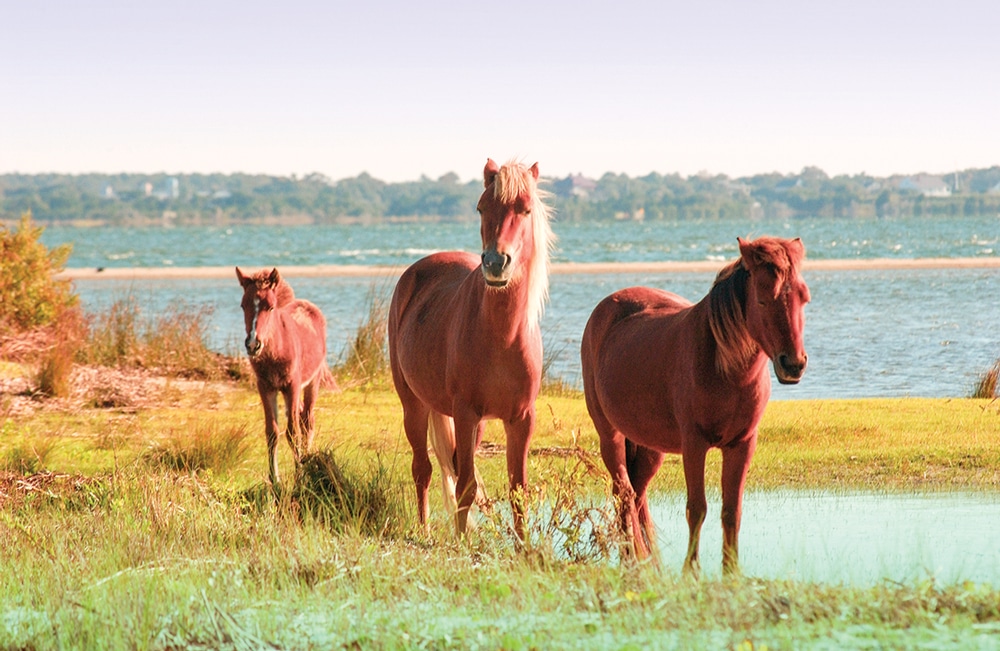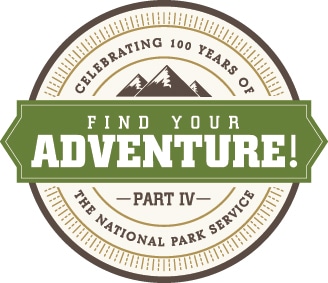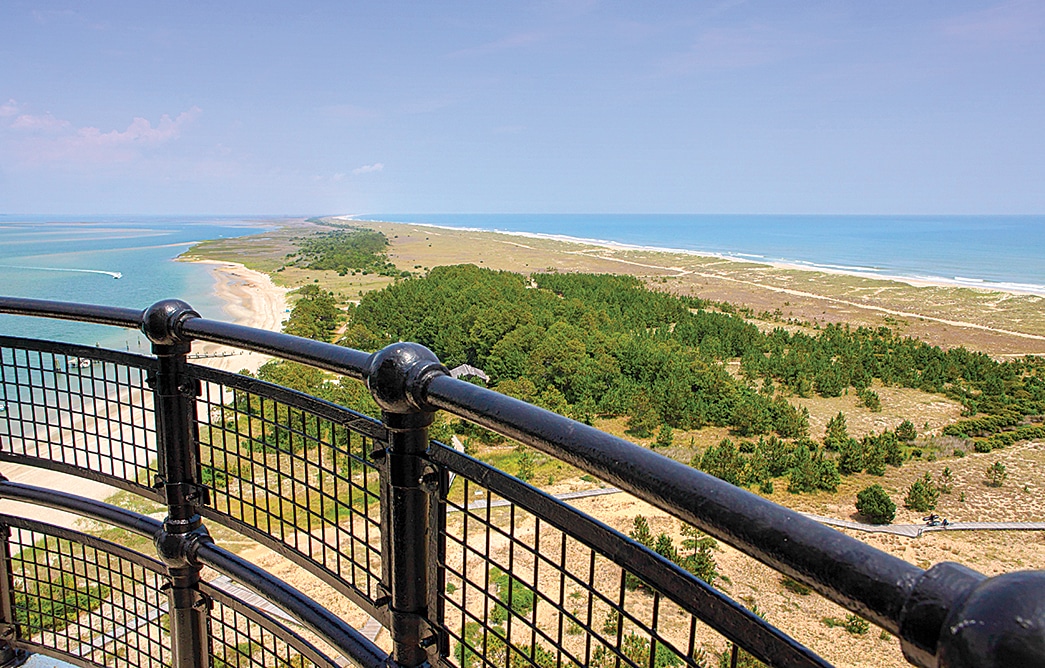Cape Hatteras and Cape Lookout national seashores make fine places to be marooned for days on end
When we think of the National Park Service (NPS), we generally think of just that: national parks. The fact of the matter, however, is that for the past century, the NPS has been faithfully standing guard over  a wide array of America’s most valuable treasures, everything from vast nature preserves to historic battlefields. Now, as we celebrate the organization’s 100th anniversary, MotorHome is bringing you a yearlong series full of unforgettable experiences – from mild to wild – that are unique to national parks. Places where we sincerely hope you’ll Find Your Adventure in the months ahead.
a wide array of America’s most valuable treasures, everything from vast nature preserves to historic battlefields. Now, as we celebrate the organization’s 100th anniversary, MotorHome is bringing you a yearlong series full of unforgettable experiences – from mild to wild – that are unique to national parks. Places where we sincerely hope you’ll Find Your Adventure in the months ahead.
It’s a fantasy most of us have indulged at one time or another, usually while fighting rush-hour traffic or beating back the onslaught of text messages, emails and phone calls that never seem to stop coming. Namely, getting away to a deserted island where the biggest decision you have to make is whether to lay back and crack open that new novel you’ve been looking forward to or do a little beachcombing along miles of deserted sand.

This painting of Blackbeard was created by Don Maitz, whose most recognized work is the Captain Morgan Spiced Rum character.
If you sigh and write off this scenario as just another wistful daydream, there’s good news. Because this idyllic reality is an everyday occurrence along the 126-mile stretch of Atlantic coastline that’s been designated the Cape Hatteras and Cape Lookout national seashores.
A Different Kind of Park
Located on the string of low barrier islands known as North Carolina’s Outer Banks about three hours east of Raleigh, these two protected seashores are watched over by the National Park Service.
That makes them a welcome respite from the overdevelopment that characterizes so much of America’s prime oceanfront property. Aside from a few isolated towns along the way, the entire trip from Beaufort north to Nags Head is largely devoid of the cheap vacation condos and schlocky T-shirt shops such long stretches of unspoiled beach normally attract.
That alone makes this undeveloped seashore a perfect spot to find your adventure. Whether it’s blissful relaxation you seek or something to get the blood pumping, you’ll find it here.
Perhaps the best news, though, is that this part of North Carolina is ideally suited to motorhome travel. Whether you decide to leave the coach at your campsite or employ it as a vessel of exploration that will allow you to set up your castaway-for-a-day basecamp amid the sea oat-studded dunes, you’ll find this stretch of coastline to be remarkably RV-friendly.
A Pirate’s Life For Me
Of course motorhome travelers aren’t the first to discover the appeal of these narrow spits of sand. In fact, one of the island’s earliest visitors was so famous he was known by a single name: Blackbeard.
That’s right, the man otherwise known as Edward Teach, who became one of the most notorious pirates of the West Indies, called the protected harbor near Ocracoke Inlet home for much of his freebooter career.
To get a glimpse of Blackbeard’s life and times, visit the Graveyard of the Atlantic Museum in Hatteras and the North Carolina Maritime Museum in Beaufort. There you’ll find out more about Teach’s larcenous enterprise and be able to view artifacts from his ship, the Queen Anne’s Revenge, which was scuttled just a mile offshore in 1718 and has only recently been raised from the depths.
To claim your share of modern-day pirate booty, visit Teach’s Hole on Ocracoke Island. There you’ll find all manner of buccaneer-themed tchotchkes as well as a small Blackbeard Museum, all within walking distance of the bay where Edward Teach was ambushed by members of the Royal Navy and quite literally lost his head.

The Roanoke Marshes Lighthouse in Manteo is an exterior re-creation of the original screw-pile lighthouse built in 1877.
The Lost Colony
When it comes to the area’s earliest recorded history, however, there’s just one place to go: the northern tip of Roanoke Island, the site of the first English colony founded on these shores in 1585.
There, at the waterfront amphitheater at the Fort Raleigh National Historic Site, you’ll find the outdoor drama The Lost Colony. Staged here on the site of that original outpost for more than 75 years, the play tells the story of the trials and tribulations faced by the 117 early settlers, with elaborate costumes and impressive special effects.
More importantly, it leaves you to ponder the mystery of what happened to those brave souls who vanished without a trace a full 30 years before the Pilgrims ever set foot on Plymouth Rock.
Light-Up Landmarks
When it comes to getting the lay of the land (and water) on the Outer Banks, nothing beats the two most prominent lighthouses that serve as important landmarks along the Cape Hatteras and Cape Lookout national seashores.
Topping that list is the Cape Hatteras Light, the tallest in the U.S., located near the town of Buxton. Built in 1870 to warn mariners of the treacherous waters of Diamond Shoals just offshore, the circular walkway atop the 210-foot black-and-white striped lighthouse offers an unparalleled panorama of the Atlantic Ocean, Pamlico Sound and the milewide island itself. While you’re admiring this massive brick structure, take a moment to contemplate the 1999 undertaking that saw the entire lighthouse moved more than a half-mile inland after decades of coastal erosion threatened to undermine its foundation.
Getting to the Cape Lookout Lighthouse requires a little more effort, as there are no roads leading to it. Interisland shuttles will whisk you across the 3-mile bay known as the Back Sound to the light with its distinctive black diamonds on a white background. Once there you can climb the 207 steps to the viewing platform or simply admire it from the ground as you walk through the warm waters lapping on miles of largely unpeopled beach.

The wild horses on Shackleford Banks are descendants of Spanish mustangs that were brought to North Carolina five centuries ago.
Horsin’ Around
No one knows for sure where the 100-plus wild horses that call the small island of Shackleford Banks came from, but it’s assumed they’re descendants of Spanish mustangs that waded ashore centuries ago after shipwrecks.
To view these herds up close, take one of the small skiffs that shuttle people to and from the end-of-the-road spot they call Harkers Island. The boat will drop you and your party off on Shackleford Banks, where you can enjoy watching the wild horses quietly graze on the lush grasses of the island’s interior.
The fact that this small 9-mile-long island is rarely visited gives it another appealing quality: a superabundance of seashells. You’ll find them lining the beach in numbers that would put a seaside curio shop to shame, especially after storms.
Adventure, Anyone?
For visitors looking for something a tad more exciting, continue north to a little spot with the somewhat ominous moniker Kill Devil Hills.
If that name sounds familiar, it’s because these giant sand dunes were the site of the Wright Brothers’ first successful glider flight in 1900. Consistent winds off the ocean still make it a prime place to do a little flying of your own.
To get off the ground, you’ll want to visit the folks at Kitty Hawk Kites at one of their multiple locations along the Outer Banks. From there you can go on to learn to paraglide or hang glide, or even kite surf on the shallow, waist-deep waters of Pamlico Sound.
For the ultimate in authentic experiences, however, ask them about taking a ride on their detailed replica of one of Orville and Wilbur’s first unpowered gliders. Though it’s unlikely you’ll travel much farther than the brothers did, it’s a brush with history that will give you stories to tell for the rest of your days.
Castaway For Days
No matter how you end up spending your time along the Cape Hatteras and Cape Lookout national seashores, you’ll finally know what it’s like to live out that recurring island castaway fantasy that gets you through your daily grind. You’ll also have an entirely new perspective on the popular phrase “life’s a beach.”
If You Go
Exploring the Cape Hatteras and Cape Lookout national seashores is a relatively straightforward affair. Traveling from the south, pick up U.S. Highway 70 near the port of Beaufort and follow it north to the Cedar Island ferry landing. At the end of the two-hour ferry ride to Ocracoke Island, you’ll find yourself on state Route 12, which, after another one-hour ferry ride from Ocracoke to Hatteras, takes you all the way up to the byway’s northern terminus at the intersection of U.S. Highway 64 to Manteo. Most turns, including the detour to Harkers Island, are well-marked. Ferry schedules and fare information can be had at www.ncdot.gov/ferry or by calling 800-293-3779.
Because grocery stores and fuel stations can be scarce along much of the route, it’s a good idea to stock up and top off in Beaufort or in one of the small towns on Hatteras Island.
For More Information
Camp Hatteras
252-987-2777 | www.camphatteras.com
Cape Hatteras National Seashore
252-473-2111 | www.nps.gov/caha
Cape Lookout National Seashore
252-728-2250 | www.nps.gov/calo
Cape Woods Campground
252-995-5850 | http://capewoods.com
Hatteras Sands Campground
252-986-2422 | www.hatterassandsrvpark.com
Kitty Hawk Kites
252-441-2426 | www.kittyhawk.com
The Lost Colony
252-473-2127 | http://thelostcolony.org
North Carolina Maritime Museums
252-728-7317 | http://ncmaritimemuseums.com
Teach’s Hole
252-928-1718 | http://teachshole.com
NPS CAMPGROUNDS
There are four campgrounds on Cape Hatteras National Seashore. Cape Point (located in Buxton) has 202 sites; Frisco has 127 sites; Ocracoke has 136 sites and Oregon Inlet (located in Nags Head) has 120 sites. None of the sites have hookups, but the campgrounds do have modern restrooms, potable water, unheated showers, barbecue grills and tables. Dump stations are located near all campgrounds except Frisco.




